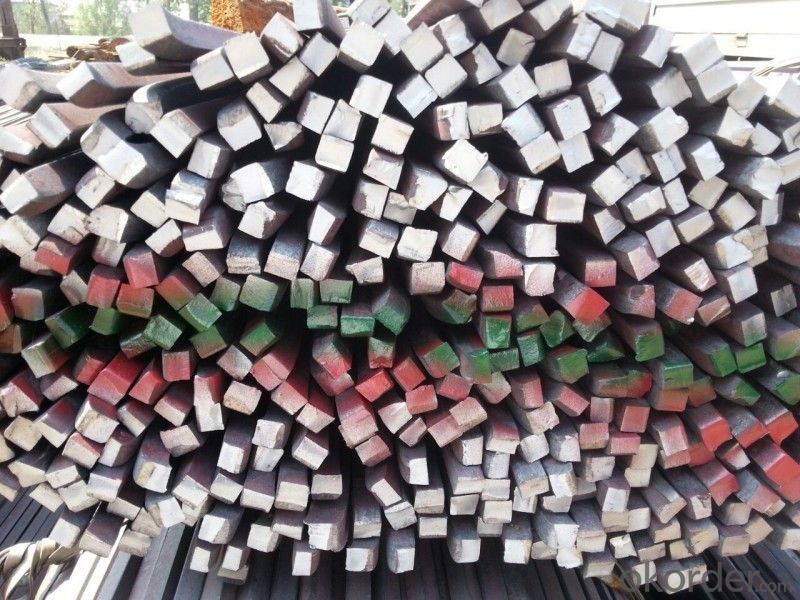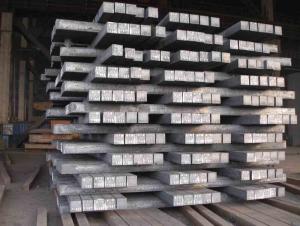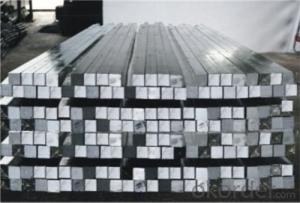Low Carbon Hot Rolled Steel Square Bar High Quality
- Loading Port:
- Shanghai
- Payment Terms:
- TT OR LC
- Min Order Qty:
- 50 m.t.
- Supply Capability:
- 10000 m.t./month
OKorder Service Pledge
OKorder Financial Service
You Might Also Like
Item specifice
Low Carbon Hot Rolled Steel Square Bar in Bundle
Product Description:
OKorder is offering Low Carbon Hot Rolled Steel Square Bar in Bundle at great prices with worldwide shipping. Our supplier is a world-class manufacturer of steel, with our products utilized the world over. OKorder annually supplies products to African, South American and Asian markets. We provide quotations within 24 hours of receiving an inquiry and guarantee competitive prices.
Product Applications:
Low Carbon Hot Rolled Steel Square Bar in Bundle are ideal for structural applications and are widely used in the construction of buildings and bridges, and the manufacturing, petrochemical, and transportation industries.
Main Product Features:
· Premium quality
· Prompt delivery & seaworthy packing (30 days after receiving deposit)
· Corrosion resistance
· Can be recycled and reused
· Mill test certification
· Professional Service
· Competitive pricing
Product Specifications:
Manufacture: Hot rolled
Grade: Q195 – 235
Certificates: ISO, SGS, BV, CIQ
Length: 6m – 12m, as per customer request
Packaging: Export packing, nude packing, bundled
| SQUARE BAR | |
| SIZE a(mm) | theoretical kg/m |
| 5.5 | 0.237 |
| 6 | 0.283 |
| 7 | 0.385 |
| 8 | 0.502 |
| 9 | 0.636 |
| 10 | 0.785 |
| 11 | 0.95 |
| 12 | 1.13 |
| 13 | 1.33 |
| 14 | 1.54 |
| 15 | 1.77 |
| 16 | 2.01 |
| 17 | 2.27 |
| 18 | 2.54 |
| 19 | 2.83 |
| 20 | 3.14 |
| 21 | 3.46 |
| 22 | 3.8 |
| 24 | 4.52 |
| 25 | 4.91 |
| 26 | 5.31 |
| 28 | 6.15 |
| 30 | 7.06 |
| 32 | 8.04 |
| 34 | 9.07 |
| 36 | 10.2 |
| 38 | 11.3 |
| 40 | 12.6 |
| 42 | 13.8 |
| 45 | 15.9 |
| 48 | 18.1 |
| 50 | 19.6 |
| 53 | 22 |
| 56 | 24.6 |
| 60 | 28.3 |
| 63 | 31.2 |
| 65 | 33.2 |
| 70 | 38.5 |
| 75 | 44.2 |
| 80 | 50.2 |
| 85 | 56.7 |
| 90 | 63.6 |
| 95 | 70.8 |
| 100 | 78.5 |

- Q:How do you use a steel square to determine rafter lengths?
- To determine rafter lengths using a steel square, you need to follow a few steps. First, line up the heel of the square against the rafter's bottom edge. Next, locate the common rafter pitch on the square's body and mark it on the rafter. Then, pivot the square until the desired rise measurement aligns with the mark. Finally, read the length measurement on the body of the square, which will give you the accurate rafter length.
- Q:What are the different ways to hold a steel square when making angle measurements?
- There are several different ways to hold a steel square when making angle measurements. 1. The first and most common method is to hold the steel square firmly against the material being measured, ensuring that both edges of the square are in contact with the material. This allows for accurate angle measurements by aligning the square's edges with the desired angle. 2. Another way is to use a clamp or a vise to secure the steel square in place. This method is particularly useful when working with larger materials or when needing to make multiple angle measurements without the risk of the square moving. 3. One can also use a magnetic base or a magnetic holder to attach the steel square to the material. This provides stability and allows for hands-free operation, especially when working with vertical or overhead surfaces. 4. For more precise angle measurements, a protractor or angle finder can be used in conjunction with the steel square. By aligning the square's edge with the desired angle and then measuring the angle using the protractor or angle finder, accurate measurements can be obtained. 5. In some cases, a steel square can also be clamped onto a sliding bevel or adjustable bevel, which allows for the setting of custom angles. This method is particularly useful when working with irregular or non-standard angles. Ultimately, the choice of how to hold a steel square when making angle measurements depends on the specific application, the size of the material being measured, and the desired level of accuracy.
- Q:How do you use a steel square to determine the width of a drawer front?
- To use a steel square to determine the width of a drawer front, you will need to follow a few simple steps. First, place the steel square on the edge of the drawer front, making sure that one of its arms is resting against the front face of the drawer. Next, slide the square along the edge of the drawer front until the other arm of the square reaches the desired width measurement. This can be done by aligning the markings on the square with the desired width measurement on the edge of the drawer front. Once the square is properly aligned, you can use a pencil or a scribe to mark the width measurement directly onto the drawer front. Finally, use a straight edge or a saw to cut along the marked line, ensuring that the cut is straight and accurate. This will give you the desired width for your drawer front. Using a steel square in this manner allows for precise measurements and helps to ensure that your drawer front is cut to the correct width.
- Q:Can a steel square be used for precision measuring?
- Yes, a steel square can be used for precision measuring. A steel square, also known as a combination square, is a versatile measuring tool that is commonly used in woodworking and metalworking. It consists of a steel blade and a steel head, which can be adjusted and locked at various angles to accurately measure and mark materials. Steel squares are designed to be accurate and reliable, with clear markings and precise measurements. They can be used for a variety of measurements, such as determining right angles, measuring and marking 45-degree angles, checking the flatness of surfaces, and transferring measurements. The steel construction ensures durability and stability, making it suitable for precise measurements over extended periods of time. However, it is important to note that while steel squares can provide precise measurements, they have their limitations. They may not be suitable for measuring extremely small dimensions or for highly sensitive measurements that require specialized tools. In such cases, more precise measuring instruments, such as micrometers or calipers, may be required. Nonetheless, for most general precision measuring tasks, a steel square can be a reliable and accurate tool.
- Q:Can a steel square be used for marking and cutting wood?
- Absolutely! When it comes to marking and cutting wood, a steel square is the way to go. This versatile tool is a common sight in woodworking, as it serves multiple purposes such as measuring, marking, and ensuring the accuracy of right angles. Crafted from top-notch steel, it boasts a lengthy blade and a shorter tongue that converge at a perfect 90-degree angle. The lengthy blade comes in handy for marking straight lines on wood, while the shorter tongue excels at marking perpendicular lines. Moreover, the edges of this steel square can double as a helpful guide when making precise cuts with a saw. All in all, if you're a woodworker, this tool is an absolute must-have for marking and cutting wood efficiently.
- Q:How do you use a steel square to measure the height of a countertop?
- To measure the height of a countertop using a steel square, follow these steps: 1. First, ensure that both the countertop and the steel square are clean and free of debris. 2. Position the steel square vertically against the countertop's edge, making sure it is flush with the surface. 3. Firmly hold the square in place with one hand. 4. Utilize a tape measure or ruler to determine the distance between the floor and the bottom of the steel square. This measurement will provide the countertop's height. 5. Take accurate and precise measurements, ensuring that the steel square remains straight against the countertop's edge for an accurate reading. 6. Repeat the measurement process at various points along the countertop's edge for consistency. This is especially crucial if the countertop is uneven or if you need to measure different sections of it. 7. Once all the necessary measurements are taken, calculate the average height of the countertop by adding them up and dividing by the total number of measurements. Using a steel square to measure a countertop's height is a straightforward and reliable method that yields accurate results. Remember to be cautious and focused while taking measurements to achieve the best possible outcome.
- Q:How do you use a steel square to mark out parallel lines on irregular surfaces?
- To use a steel square to mark out parallel lines on irregular surfaces, follow these steps: 1. Ensure that the steel square is clean and free from any dirt or debris. This will help maintain accurate measurements. 2. Identify the two points on the irregular surface where you want to mark the parallel lines. It could be the edges of a board or any other reference points you choose. 3. Place the steel square on the surface, aligning one side of the square with one of the reference points. Hold the square firmly in place. 4. Using a pencil or a scribe, slide it along the edge of the square, marking a line on the surface. 5. Now, align the same side of the square with the other reference point and repeat the process of marking a line. 6. You will now have two parallel lines marked on the irregular surface, equidistant from the reference points. 7. If you need to mark more parallel lines, simply repeat steps 3 to 6, aligning the square with the previously marked lines. It's important to note that the accuracy of the parallel lines will depend on the precision of your measurements and the stability of the steel square during the marking process. Also, be cautious of any irregularities or bumps on the surface that may affect the accuracy of the lines.
- Q:Can a steel square be used for checking the squareness of shelving units?
- Yes, a steel square can be used for checking the squareness of shelving units. A steel square is a reliable tool commonly used in carpentry and woodworking to determine the squareness of corners and angles. It has a 90-degree angle and is made of durable steel, ensuring accurate measurements. By placing the steel square against the corners of a shelving unit, one can easily check if the corners are perfectly square or not. This is important for ensuring stability and proper alignment of the shelving unit, especially if it will be loaded with heavy items.
- Q:Can a steel square be used for checking the squareness of table legs?
- Yes, a steel square can be used for checking the squareness of table legs. The straight edges and right angles of a steel square make it useful for ensuring that the legs are perpendicular to the tabletop, which is essential for stability and balance.
1. Manufacturer Overview |
|
|---|---|
| Location | |
| Year Established | |
| Annual Output Value | |
| Main Markets | |
| Company Certifications | |
2. Manufacturer Certificates |
|
|---|---|
| a) Certification Name | |
| Range | |
| Reference | |
| Validity Period | |
3. Manufacturer Capability |
|
|---|---|
| a)Trade Capacity | |
| Nearest Port | |
| Export Percentage | |
| No.of Employees in Trade Department | |
| Language Spoken: | |
| b)Factory Information | |
| Factory Size: | |
| No. of Production Lines | |
| Contract Manufacturing | |
| Product Price Range | |
Send your message to us
Low Carbon Hot Rolled Steel Square Bar High Quality
- Loading Port:
- Shanghai
- Payment Terms:
- TT OR LC
- Min Order Qty:
- 50 m.t.
- Supply Capability:
- 10000 m.t./month
OKorder Service Pledge
OKorder Financial Service
Similar products
New products
Hot products
Related keywords

























